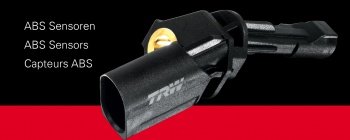
FOR ITS OE QUALITY ABS SENSOR PROGRAMME
TRW Automotive Aftermarket, has announced the publication of a 2013-14 catalogue to accompany its market leading original equipment (OE) quality Anti-Lock Braking (ABS) sensor programme. This news further highlights TRW’s position as an automotive safety expert and the leading global supplier of ‘Corner Module’ systems (braking, steering & suspension).
Catering for all major European and Asian vehicle manufacturers, the catalogue, part number: XDB92OB, contains 176 pages, detailing 238 part numbers across 22 passenger car (PC) and light commercial vehicle (LCV) manufacturers. The publication is divided into three sections: an applications section; a buyer’s guide and an OE cross referencing section, and is both comprehensive and easy to use.

“With constant advances in automotive technology and the number of electronic components in vehicles ever increasing, ABS sensors and electronics are a growing area and represent a huge opportunity for the global aftermarket,” explained TRW’s global marketing services manager, Soeren Kristensen.
“These sensors play a pivotal role in the operation of a vehicle’s ABS system; which greatly enhances driver safety by controlling brake force and allowing the vehicle to slow down as quickly, yet as safely, as possible.”
ABS sensors need to be able to generate and communicate precise data in any given situation, regardless of outside movement, temperature or other extraneous variable. TRW sensors are made of special sensors plastics like thermoplastic polyester or fiberglass reinforced polyamides, which also have excellent electrotechnical and electromechanical characteristics, making them incredibly robust. Because of this, the sensors and connected cables are able to withstand extremes of temperature - operating in a spectrum ranging from -40°C up to +125°C, and can ultimately provide a high level of safety.
“TRW’s OE quality programme is tested to the extreme. Sophisticated equipment measures microsecond responses and data accuracy throughout a wide range of manoeuvres, both in the lab and on the road,” Soeren continued.
ABS speed sensors monitor the rotation of each tire and measure the speed of the wheels. The electronic control unit (ECU) processes this information and any slippage or difference between the wheels triggers the ABS system. If the ABS sensors detect a loss of wheel traction, a valve system is engaged that controls the brake fluids in the lines. Since brakes work based on pressure generated by fluid compressed in the brake lines, a pump engages in the braking system to override manual braking and rapidly apply the brakes. This application occurs faster than any human can apply the brakes.
Advanced driver assistance systems like stability control, launch control, inbuilt GPS or hill hold also rely on ABS sensors to detect wheel speed to assist the driver and improve driving safety; if one sensor fails, typically the whole system will be switched off. Navigation systems also benefit from the signals of these sensors as they use the information to calculate the distance travelled.
“As our research shows that these technologies are among the fastest growing mass market technologies, the scope for market growth is immense as the failure of a single sensor can cause the failure of other data dependent systems,” Soeren concluded.
TRW’s OE quality ABS sensor programme consists of both active and passive wheel speed sensors. Active sensors need to run an additional power source; passive sensors operate without an external energy source.
TRW Automotive news is available on the internet at www.trw.com.


 Click here to open the navigation menu
Click here to open the navigation menu